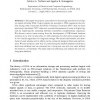Free Online Productivity Tools
i2Speak
i2Symbol
i2OCR
iTex2Img
iWeb2Print
iWeb2Shot
i2Type
iPdf2Split
iPdf2Merge
i2Bopomofo
i2Arabic
i2Style
i2Image
i2PDF
iLatex2Rtf
Sci2ools
ICNC
2005
Springer
2005
Springer
On Designing DNA Databases for the Storage and Retrieval of Digital Signals
Abstract. In this paper we propose a procedure for the storage and retrieval of digital signals utilizing DNA. Digital signals are encoded in DNA sequences that satisfy among other constraints the Noise Tolerance Constraint (NTC) that we have previously introduced. NTC takes into account the presence of noise in digital signals by exploiting the annealing between non-perfect complementary sequences. We discuss various issues arising from the development of DNA-based database solutions (i) in vitro (in test tubes, or other materials) for short-term storage and (ii) in vivo (inside organisms) for long-term storage. We discuss the benefits and drawbacks of each scheme and its effects on the codeword design problem and performance. We also propose a new way of constructing the database elements such that a short-term database can be converted into a long term one and vice versa without the need for a re-synthesis. The latter improves efficiency and reduces the cost of a long-term database....
| Added | 27 Jun 2010 |
| Updated | 27 Jun 2010 |
| Type | Conference |
| Year | 2005 |
| Where | ICNC |
| Authors | Sotirios A. Tsaftaris, Aggelos K. Katsaggelos |
Comments (0)

